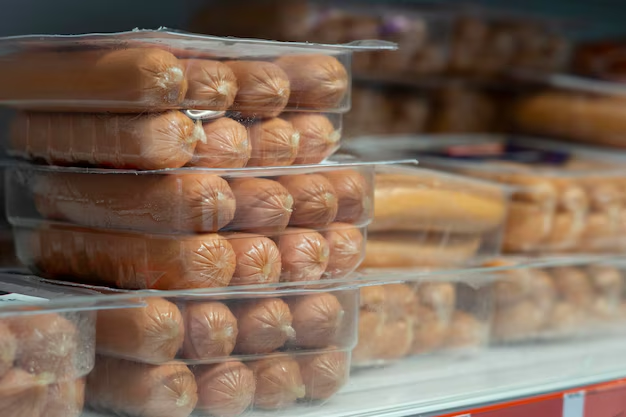How Long Does Breakfast Sausage Stay Fresh in Your Fridge? 🤔
Breakfast sausage is a staple in many kitchens, offering a delicious and savory start to the day. But have you ever stood in front of your refrigerator, breakfast sausage in hand, wondering if it's still safe to eat? Understanding how long breakfast sausage lasts in the refrigerator is crucial not only for food safety but also for the enjoyment of your meals. In this guide, we'll explore everything you need to know about storing breakfast sausage, ensuring it's as tasty and safe as the day you bought it.
The Lifespan of Breakfast Sausage in the Refrigerator
Understanding Sausage Types
Breakfast sausage can generally be categorized into two types: fresh (uncooked) and pre-cooked. The storage lifespan for each type differs due to their varying preparation methods.
Fresh Sausage:
- Raw, uncooked sausage.
- Often sold in casings or as bulk sausage.
Pre-Cooked Sausage:
- Sausage that’s been cooked during the production process.
- Comes in the form of links or patties.
Fresh Breakfast Sausage
Fresh sausage requires more attentive handling because it hasn’t been cooked. Typically, it should be stored in the refrigerator below 40°F (4°C) to maintain safety and freshness. Here’s how long you can expect it to last:
- Refrigerator Storage: Fresh breakfast sausage can last 1 to 2 days.
- Freezer Storage: If you need longer storage, consider freezing, where it can remain safe for about 1 to 2 months while maintaining its best quality.
Pre-Cooked Breakfast Sausage
Pre-cooked sausages offer the convenience of being ready-to-eat after simple heating. Their shelf life in the refrigerator is slightly longer:
- Refrigerator Storage: Pre-cooked sausage typically lasts up to 7 days.
- Freezer Storage: When frozen, it remains at its best quality for up to 2 months.
Ensuring Freshness: Signs Your Sausage Has Gone Bad 🚫
Remaining vigilant about the condition of your breakfast sausage is essential. Here are some key indicators that your sausage may no longer be safe to eat:
- Odor: A sour or off smell indicates spoilage.
- Texture: Slimy or sticky sausage suggests bacterial growth.
- Color: If it turns grayish or brown from its original pink hue, it might be time to toss it.
Visual and Sensory Checks
Conduct regular visual and sensory checks to ensure that your food storage is working effectively:
- Always examine packaging for excessive air or puffing—signals that bacterial activity is underway.
- Be mindful of any mold, particularly in fresh sausages.
Best Practices for Storing Breakfast Sausage 🥶
Proper storage plays a critical role in extending the life of your breakfast sausage. Here are some actionable storage tips:
In the Refrigerator
- Maintain Temperature: Keep your refrigerator below 40°F (4°C) to slow bacterial growth.
- Original Packaging: Store sausages in their original packaging if unopened, or seal them tightly in air-tight containers if opened.
- Use by Date: Always prioritize the "use by" date on packaging as a guideline for freshness.
In the Freezer
- Pre-portion for Convenience: Divide bulk sausages into meal-sized portions to prevent thawing and refreezing.
- Effective Wrapping: Use aluminum foil, plastic wrap, or freezer bags to seal your sausage properly, preventing freezer burn.
Safe Preparation and Consumption 🍽️
Proper preparation enhances safety and taste. Follow these tips to ensure breakfast sausage is delicious and safe from your fridge to your plate:
Cooking Guidelines
- Fresh Sausages: Cook to an internal temperature of 160°F (71°C) to ensure harmful bacteria are eliminated.
- Reheating Pre-Cooked Sausages: Heat to at least 165°F (74°C) for best results.
Meal Ideas and Serving Suggestions
- Pair with classic scrambled eggs for a hearty breakfast.
- Incorporate into casseroles or breakfast burritos for a creative twist.
The Environmental Impact: Reducing Food Waste 🌍
Mindful food storage not only saves money but also reduces environmental impact by minimizing food waste. When planning meals:
- Plan Effectively: Buy only what you can store and consume within the shelf life.
- Creative Use of Leftovers: Reinvent your sausage leftovers in new dishes.
Key Takeaways 🌟
A cheat sheet to remember how long and how best to store breakfast sausages:
- Fresh Sausage:
- Refrigerate up to 2 days.
- Freeze for up to 2 months.
- Pre-Cooked Sausage:
- Refrigerate up to 7 days.
- Freeze for up to 2 months.
- Signs of Spoilage: Odor, texture, and color changes.
- Storage Tips: Maintain sealing, temperature, and portioning.
- Creative Use Ideas: Breakfast burritos, casseroles, or alongside eggs.
Staying knowledgeable about shelf life and proper storage practices empowers you to make informed decisions and enjoy your breakfast sausage with peace of mind. As you plan your meals and manage your refrigerator space, these guidelines will help you maintain both the safety and the satisfaction of a well-prepared breakfast. Enjoy your mornings with the assurance that your food storage tactics are on point!
